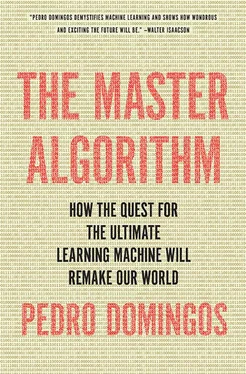The effort to build what will ultimately become CanceRx is already under way. Researchers in the new field of systems biology model whole metabolic networks rather than individual genes and proteins. One group at Stanford has built a model of a whole cell. The Global Alliance for Genomics and Health promotes data sharing among researchers and oncologists, with a view to large-scale analysis. CancerCommons.org assembles cancer models and lets patients pool their histories and learn from similar cases. Foundation Medicine pinpoints the mutations in a patient’s tumor cells and suggests the most appropriate drugs. A decade ago, it wasn’t clear if, or how, cancer would ever be cured. Now we can see how to get there. The road is long, but we have found it.
CHAPTER TEN: This Is the World on Machine Learning
Now that you’ve toured the machine learning wonderland, let’s switch gears and see what it all means to you. Like the red pill in The Matrix , the Master Algorithm is the gateway to a different reality: the one you already live in but didn’t know it yet. From dating to work, from self-knowledge to the future of society, from data sharing to war, and from the dangers of AI to the next step in evolution, a new world is taking shape, and machine learning is the key that unlocks it. This chapter will help you make the most of it in your life and be ready for what comes next. Machine learning will not single-handedly determine the future, any more than any other technology; it’s what we decide to do with it that counts, and now you have the tools to decide.
Chief among these tools is the Master Algorithm. Whether it arrives sooner or later, and whether or not it looks like Alchemy, is less important than what it encapsulates: the essential capabilities of a learning algorithm, and where they’ll take us. We can equally well think of the Master Algorithm as a composite picture of current and future learners, which we can conveniently use in our thought experiments in lieu of the specific algorithm inside product X or website Y, which the respective companies are unlikely to share with us anyway. Seen in this light, the learners we interact with every day are embryonic versions of the Master Algorithm, and our task is to understand them and shape their growth to better serve our needs.
In the coming decades, machine learning will affect such a broad swath of human life that one chapter of one book cannot possibly do it justice. Nevertheless, we can already see a number of recurring themes, and it’s those we’ll focus on, starting with what psychologists call theory of mind-the computer’s theory of your mind, that is.
Sex, lies, and machine learning
Your digital future begins with a realization: every time you interact with a computer-whether it’s your smart phone or a server thousands of miles away-you do so on two levels. The first one is getting what you want there and then: an answer to a question, a product you want to buy, a new credit card. The second level, and in the long run the most important one, is teaching the computer about you. The more you teach it, the better it can serve you-or manipulate you. Life is a game between you and the learners that surround you. You can refuse to play, but then you’ll have to live a twentieth-century life in the twenty-first. Or you can play to win. What model of you do you want the computer to have? And what data can you give it that will produce that model? Those two questions should always be in the back of your mind whenever you interact with a learning algorithm-as they are when you interact with other people. Alice knows that Bob has a mental model of her and seeks to shape it through her behavior. If Bob is her boss, she tries to come across as competent, loyal, and hardworking. If instead Bob is someone she’s trying to seduce, she’ll be at her most seductive. We could hardly function in society without this ability to intuit and respond to what’s on other people’s minds. The novelty in the world today is that computers, not just people, are starting to have theories of mind. Their theories are still primitive, but they’re evolving quickly, and they’re what we have to work with to get what we want-no less than with other people. And so you need a theory of the computer ’s mind, and that’s what the Master Algorithm provides, after plugging in the score function (what you think the learner’s goals are, or more precisely its owner’s) and the data (what you think it knows).
Take online dating. When you use Match.com, eHarmony, or OkCupid (suspend your disbelief, if necessary), your goal is simple: to find the best possible date you can. But chances are it will take a lot of work and several disappointing dates before you meet someone you really like. One hardy geek extracted twenty thousand profiles from OkCupid, did his own data mining, found the woman of his dreams on the eighty-eighth date, and told his odyssey to Wired magazine. To succeed with fewer dates and less work, your two main tools are your profile and your responses to suggested matches. One popular option is to lie (about your age, for example). This may seem unethical, not to mention liable to blow up in your face when your date discovers the truth, but there’s a twist. Savvy online daters already know that people lie about their age on their profiles and adjust accordingly, so if you state your true age, you’re effectively telling them you’re older than you really are! In turn, the learner doing the matching thinks people prefer younger dates than they really do. The logical next step is for people to lie about their age by even more, ultimately rendering this attribute meaningless.
A better way for all concerned is to focus on your specific, unusual attributes that are highly predictive of a match, in the sense that they pick out people you like that not everyone else does, and therefore have less competition for. Your job (and your prospective date’s) is to provide these attributes. The matcher’s job is to learn from them, in the same way that an old-fashioned matchmaker would. Compared to a village matchmaker, Match.com’s algorithm has the advantage that it knows vastly more people, but the disadvantage is that it knows them much more superficially. A naïve learner, such as a perceptron, will be content with broad generalizations like “gentlemen prefer blondes.” A more sophisticated one will find patterns like “people with the same unusual musical tastes are often good matches.” If Alice and Bob both like Beyoncé, that alone hardly singles them out for each other. But if they both like Bishop Allen, that makes them at least a little bit more likely to be potential soul mates. If they’re both fans of a band the learner does not know about, that’s even better, but only a relational algorithm like Alchemy can pick it up. The better the learner, the more it’s worth your time to teach it about you. But as a rule of thumb, you want to differentiate yourself enough so that it won’t confuse you with the “average person” (remember Bob Burns from Chapter 8), but not be so unusual that it can’t fathom you.
Online dating is in fact a tough example because chemistry is hard to predict. Two people who hit it off on a date may wind up falling in love and believing passionately that they were made for each other, but if their initial conversation takes a different turn, they might instead find each other annoying and never want to meet again. What a really sophisticated learner would do is run a thousand Monte Carlo simulations of a date between each pair of plausible matches and rank the matches by the fraction of dates that turned out well. Short of that, dating sites can organize parties and invite people who are each a likely match for many of the others, letting them accomplish in a few hours what would otherwise take weeks.
Читать дальше












